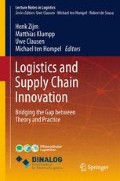Abstract
The demand for sustainable logistic and supply chain processes poses enormous challenges in terms of technology integration, the development of new business models, cultural change and job qualification, and as such requires a real paradigm shift. In this paper, we start with a brief sketch of how modern logistics and supply chains emerged as a result of diversification and specialization of industrial production, globally scattered availability of resources and more demanding consumer markets. Jointly with advances in freight transport and communication technologies, these developments have led to the global economy we face today. The strong growth of trade and consumption however also revealed some essential weaknesses of the system that renders current practices in the long run unsustainable—in social, environmental and economic terms (people, planet, profit). Future supply chains should no longer deplete scarce natural resources or contribute to climate change, should avoid environmental pollution and withstand safety and security threats, while at the same time remaining competitive and satisfying high labor quality standards. This requires not only the application of advanced technologies to mitigate or even neutralize these negative effects, but also the development of smart business models, new job qualification standards and corresponding (lifelong) training and education programs at all levels, including artificial intelligence based learning.
Access this chapter
Tax calculation will be finalised at checkout
Purchases are for personal use only
Notes
- 1.
In 2007 the world passed the point in which more than half of its population is living in urbanized areas, in some developed countries the urban population percentage is well above 70 %, and continues to rise.
- 2.
“The first and foremost objective of research and practical application shall therefore be a method securing the establishment and preservation of tree cultivation, enabling a continuous and sustainable use as this is an essential prerequisite for the well-being of the land.”
- 3.
Competence is here understood as the application of knowledge and information for a given (exemplified) real-world problem, e.g. the transportation and placement of a container in a seaport terminal or the production of a car specified by a customer.
- 4.
The chess computer IBM “Deep Blue”; the first victory was already in 1997 against Garry Kasparov, but until 2005 human players still were able to score in some cases against computers. Today in chess ranking “ELO points” computers lead unchallenged with 3304 against the best human with 2.882 (Magnus Carlsen in 2014).
References
ALICE (2014) European technology platform for logistics. http://www.etp-logistics.eu/
Aghion P, David PA, Foray D (2009) Science, technology and innovation for economic growth: linking policy research and practice in ‘STIG Systems’. Res Policy 38:681–693
Babbage Ch (1835) On the economy of machinery and manufactures, 4th edn. Charles Knight, London
Cohen M, Agrawal N, Agrawal V (2006) Winning in the aftermarket. Harvard Bus Rev 84(5):129–138
Erhan D, Bengio Y, Courville A, Manzagol P-A, Vinvent P, Bengio A (2010) Why does unsupervised pre-training help deep learning? J Mach Learn Res 11(1):625–660
Gaonkar RS, Viswanadham N (2007) Analytical framework for the management of risk in supply chains. IEEE Trans Autom Sci Eng 4(2):265–273
Hintsa J (2011) Post-2001 supply chain security—impacts on the private sector. Doctoral Thesis, HEC University of Lausanne (Chapter 7)
Hopp W, Spearman M (2008) Factory physics: foundations of manufacturing management, 3rd edn. Waveland Press Inc, Long Grove
Klumpp M (2013) How to structure logistics education: industry qualifications framework or topical structure? In: Pawar KS, Rogers H (eds) Resilient supply chains in an uncertain environment, ISL 2013 Proceedings, Vienna/Nottingham, pp 895–902
LOG2020 (2013) Logistics and supply chain management 2020: training for the future. WP2: positioning paper. ERASMUS LLL project ID: 527700-LLP-1-2012-1-NL-ERASMUS-EMCR
Meadows DH, Meadows DL, Randers J, Behrens WW III (1972) The limits to growth. Universe Books, New York
Montreuil B (2011) Towards a physical internet: meeting the global logistics sustainability grand challenge. Logistics Res 3(2–3):71–87
Neely A (2008) Exploring the financial consequences of the servitization of manufacturing. Oper Manag Res 1(2):103–119
Newell A (1982) The knowledge level. Artif Intell 18(1):87–127
Poluha RG (2007) Application of the SCOR model in supply chain management. Youngstown, New York
Shingo S (1985) A revolution in manufacturing: the SMED system. Productivity Press
Simchi-Levi D, Kaminski P, Simchi-Levi E (2008) Designing and managing the supply chain: concepts, strategies and case studies. McGraw-Hill International, Boston
Smith A (1776) An inquiry into the nature and causes of the wealth of nations. W. Strahan, London
von Carlowitz HC (1713) Sylvicultura Oeconomica oder haußwirthliche Nachricht und Naturgemäßige Anweisung zur Wilden Baum-Zucht, (edited by Johann Friedrich Braun), Leipzig
World Economic Forum/Accenture (2013) Building resilience in supply chains. An initiative of the risk response network in collaboration with Accenture, Geneva
Wu YC-J (2007) Contemporary logistics education: an international perspective. Int J Phys Distrib Logistics Manag 37(7):504–528
Zijm H, Douma A (2012) Logistics: more than transport. In: Weijers S, Dullaert W (eds) Proceedings of the 2012 freight logistics seminar. Venlo, The Netherlands, pp 395–404
Author information
Authors and Affiliations
Corresponding author
Editor information
Editors and Affiliations
Rights and permissions
Copyright information
© 2016 Springer International Publishing Switzerland
About this chapter
Cite this chapter
Zijm, H., Klumpp, M. (2016). Logistics and Supply Chain Management: Developments and Trends. In: Zijm, H., Klumpp, M., Clausen, U., Hompel, M. (eds) Logistics and Supply Chain Innovation. Lecture Notes in Logistics. Springer, Cham. https://doi.org/10.1007/978-3-319-22288-2_1
Download citation
DOI: https://doi.org/10.1007/978-3-319-22288-2_1
Published:
Publisher Name: Springer, Cham
Print ISBN: 978-3-319-22287-5
Online ISBN: 978-3-319-22288-2
eBook Packages: EngineeringEngineering (R0)

